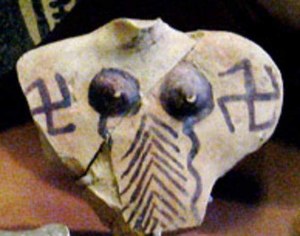Additional work was done at the site in 1937 by Erich Schmidt leading the Persepolis Expedition of the Oriental Institute of the University of Chicago.
Some limited work was done at Tall-i Bakun by a team from the Tokyo University led by Namio Egami and Seiichi Masuda in 1956. The most recent excavations were by a joint team of the Oriental Institute and the Iranian Cultural Heritage and Tourism Organisation. The site was active from circa 6th millennium BC to circa 4th millennium BC.
Three kilometers south of Persepolis, in the plain of Marv Dasht, lies the prehistoric site of Tall-i-Bakun, consisting of two flat hillocks. Here in 1928, Ernst Herzfeld, of the University of Berlin, decided to undertake a trial excavation of the western mound, where he had previously discovered many prehistoric sherds Iying about on the ground. Later, in 1932, he conducted more extensive excavations, subsequently continued by Erich F. Schmidt (1935–37).
The main deposits of the western hill produced a large quantity of ceramics with unusually beautiful painted patterns dating mostly to the fourth millennium B .C. Unexpectedly, many rooms of the settlement contained a substantial number of unbroken vessels, many of them standing on the floors of the houses, sometimes nested one in another. A great wealth of designs and variations are seen in this cream-colored ware. Many show different geometrical patterns, some simple, some intricate. Fewer have beautifully stylized animal designs depicting either ibexes or mouflons. These vessels manifest a remarkable artistic balance between geometric ornament and animal design. Large jars, usually made in two parts, show distinct markings characteristic of a vessel turned by hand.
Besides these pottery vessels, numerous painted clay figurines of humans and animals were discovered. Other ceramic objects consisted of scrapers, in the form of stirrups, which were used for smoothing and decorating vessel surfaces before the vessels were fired. These scrapers—although made of clay—were so strong, and their scraping edges so sharp, that they were also used for scraping hides. In addition to this vast amount of pottery, there were large quantities of knives, blades, and copper daggers. There were also many button seals, mostly made of green stone, showing beautifully incised designs. Finally, some well-preserved clay labels and seal impressions were excavated.
Tall-i Bakun phase A was inhabited c. 4000-3500 BCE. Four layers can be distinguished. Layer III was the best preserved and shows a settlement in which the residential buildings were built close together with no roads or paths. Individual houses consisted of several rooms. Remains of mural paintings and of wooden columns suggest a once rich interior.
Richly painted pottery was produced. There were also ceramic female figurines and those of animals. There were also cylinder seals, which indicates some type of administrative activities.
Artifactual remains from the site include objects made of copper, pottery and stone.
The wealth and variety of material items at Bakun and the evidence of large workshop areas point to the existence of local industry and connection/trade with distant regions such as the Persian Gulf, the central plateau, Kerman, and northeastern Iran whence goods like shells, copper, steatite, lapis, and turquoise were procured. If my inferences are correct, we have a settlement that is spatially arranged according to its functional needs and socio-economic organization.
Bakun culture
The Bakun culture flourished in the Fars Province of Iran in the fifth and early fourth millenniums BC. It had a long duration and wide geographical distribution. Its pottery tradition was as sophisticated as that of Susa I. Nevertheless, it was mostly a nomadic culture, and its settlements were typically much smaller than those of Susa.
Bakun pottery is known in the Fars region in the form of bowls and jugs with green, reddish brown or deep brown bands and stripes.
Outside Fars this pottery has been found in northern Khuzestan, in the Bakhtiari mountains, and in the Behbahan and Zuhreh regions.
In the late fifth and early fourth millennia BC, Bakun A settlements were at once manufacturing sites and centres for the administration of production and trade. Their painted pottery featured some unusual specific motifs, such as large-horned mountain sheep and goats, that were rare or unique elsewhere.
After the decline of Bakun, Lapui period followed. In recent publications, Bakun period is dated 4800-4100 BC, and the Lapui period is dated to 4100-3500 BC.
Source of images:The Oriental Institute of
The University of Chicago
#ghorbanycarpets #ancienthistory #ancientpersia #history #prehistoricpersia #throwbackthursday #thursday #persia #ancientcivilizations #interestingfacts



